Fifth Avenue
Fifth Avenue is a major thoroughfare in the borough of Manhattan in New York City. It stretches north from Washington Square Park in Greenwich Village to West 143rd Street in Harlem. It is considered one of the most expensive and elegant streets in the world.[3][4]
| Museum Mile | |
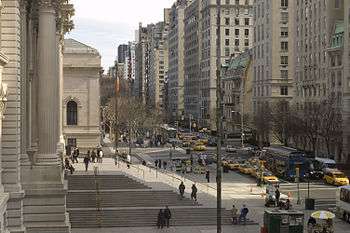 Looking northward from the Metropolitan Museum of Art at 81st Street | |
| Owner | City of New York |
|---|---|
| Maintained by | NYCDOT |
| Length | 6.197 mi[1][2] (9.973 km) |
| Location | Manhattan, New York City |
| South end | Washington Square North in Greenwich Village |
| Major junctions | Madison Square in Flatiron Grand Army Plaza in Midtown Duke Ellington Circle in East Harlem Marcus Garvey Park in Harlem Madison Avenue Bridge in Harlem |
| North end | |
| East | University Place (south of 14th) Broadway (14th to 23rd) Madison Avenue (north of 23rd) |
| West | Sixth Avenue (south of 59th) Central Park-East Drive (59th to 110th) Lenox Avenue (north of 110th) |
| Construction | |
| Commissioned | March 1811 |
Fifth Avenue carries two-way traffic from 142nd to 135th Street and carries one-way traffic southbound for the remainder of its route. The entire street used to carry two-way traffic until 1966. From 124th to 120th Street, Fifth Avenue is cut off by Marcus Garvey Park, with southbound traffic diverted around the park via Mount Morris Park West. Most of the avenue has a bus lane, though not a bike lane. Fifth Avenue is the traditional route for many celebratory parades in New York City, and is closed on several Sundays per year.
Fifth Avenue was originally only a narrower thoroughfare but the section south of Central Park was widened in 1908. The midtown blocks between 34th and 59th Streets were largely a residential area until the turn of the 20th century, when they were developed as commercial areas. The section of Fifth Avenue in the 50s is consistently ranked among the most expensive shopping streets in the world, and the section between 59th and 96th Streets across Central Park was nicknamed "Millionaire's Row" in the early 20th century due to the high concentration of mansions there. A section of Fifth Avenue running from 82nd to 110th Streets, also alongside Central Park, is also nicknamed Museum Mile due to the large number of museums there.
History
5th Avenue was originally only a narrower thoroughfare but the section south of Central Park was widened in 1908, sacrificing its wide sidewalks to accommodate the increasing traffic.
The midtown blocks were largely a residential area until the turn of the 20th century, when they were developed as commercial areas.[5][6] The first commercial building on Fifth Avenue was erected by Benjamin Altman who bought the corner lot on the northeast corner of 34th Street in 1896. In 1906 the B. Altman and Company Building was erected, occupying the whole of its block front. The result was the creation of a high-end shopping district that attracted fashionable women and the upscale stores that wished to serve them. The Lord & Taylor Building, formerly Lord & Taylor's flagship store and now a WeWork office, is located on Fifth Avenue near the Empire State Building and the New York Public Library Main Branch.
In the 1920s, traffic towers controlled important intersections from 14th to 59th Streets.
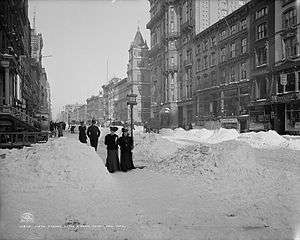
Description
Fifth Avenue originates at Washington Square Park in Greenwich Village and runs northwards through the heart of Midtown, along the eastern side of Central Park, where it forms the boundary of the Upper East Side and through Harlem, where it terminates at the Harlem River at 142nd Street. Traffic crosses the river on the Madison Avenue Bridge. Fifth Avenue serves as the dividing line for house numbering and west-east streets in Manhattan, just as Jerome Avenue does in the Bronx. It separates, for example, East 59th Street from West 59th Street.
From this zero point for street addresses, numbers increase in both directions as one moves away from Fifth Avenue, The building lot numbering system worked similarly on the East Side as well, before Madison & Lexington Aves. were retrofitted into the street grid, confusing the building numbers. Confusingly, an address on a cross street cannot be predicted at the intersection of Madison Ave. or Lexington Ave., as these were added decades after the building numbers. It's as if the two retrofitted avenues are not counted for purposes of cross street addresses.
The "most expensive street in the world" moniker changes depending on currency fluctuations and local economic conditions from year to year. For several years starting in the mid-1990s, the shopping district between 49th and 57th Streets was ranked as having the world's most expensive retail spaces on a cost per square foot basis.[4] In 2008, Forbes magazine ranked Fifth Avenue as being the most expensive street in the world. Some of the most coveted real estate on Fifth Avenue are the penthouses perched atop the buildings.[7]
The American Planning Association (APA) compiled a list of "2012 Great Places in America" and declared Fifth Avenue to be one of the greatest streets to visit in America. This historic street has many world-renowned museums, businesses and stores, parks, luxury apartments, and historical landmarks that are reminiscent of its history and vision for the future.[8] By 2018 portions of Fifth Avenue had large numbers of vacant store fronts for long periods, part of a citywide trend of vacant store fronts attributed to high rental costs.[9]
Traffic pattern
Fifth Avenue from 142nd Street to 135th Street carries two-way traffic. Fifth Avenue carries one-way traffic southbound from 143rd Street to 142nd Street and from 135th Street to Washington Square North. The changeover to one-way traffic south of 135th Street took place on January 14, 1966, at which time Madison Avenue was changed to one way uptown (northbound).[10] From 124th Street to 120th Street, Fifth Avenue is cut off by Marcus Garvey Park, with southbound traffic diverted around the park via Mount Morris Park West.
%2C_at_the_244th_Annual_NYC_St._Patrick's_Day_parade.jpg)
Parade route
Fifth Avenue is the traditional route for many celebratory parades in New York City; thus, it is closed to traffic on numerous Sundays in warm weather. The longest running parade is the annual St. Patrick's Day Parade. Parades held are distinct from the ticker-tape parades held on the "Canyon of Heroes" on lower Broadway, and the Macy's Thanksgiving Day Parade held on Broadway from the Upper West Side downtown to Herald Square. Fifth Avenue parades usually proceed from south to north, with the exception of the LGBT Pride March, which goes north to south to end in Greenwich Village. The Latino literary classic by New Yorker Giannina Braschi, entitled "Empire of Dreams", takes place on the Puerto Rican Day Parade on Fifth Avenue.[11][12]
Bicycling route
Bicycling on Fifth Avenue ranges from segregated with a bike lane south of 23rd Street, to scenic along Central Park, to dangerous through Midtown with very heavy traffic during rush hours.[13] There is no dedicated bike lane along Fifth Avenue.
In July 1987, then New York City Mayor Edward Koch proposed banning bicycling on Fifth, Park, and Madison Avenues during weekdays, but many bicyclists protested and had the ban overturned.[14] When the trial was started on Monday, August 24, 1987 for 90 days to ban bicyclists from these three avenues from 31st Street to 59th Street between 10 a.m. and 4 p.m. on weekdays, mopeds would not be banned.[15] On Monday, August 31, 1987, a state appeals court judge halted the ban for at least a week pending a ruling after opponents against the ban brought a lawsuit.[16]
Public transportation
Fifth Avenue is one of the few major streets in Manhattan along which streetcars did not operate. Instead, Fifth Avenue Coach offered a service more to the taste of fashionable gentlefolk, at twice the fare. Double-decker buses were operated by the Fifth Avenue Coach Company until 1953, and again by MTA Regional Bus Operations from 1976 to 1978.[17] Today, local bus service along Fifth Avenue is provided by the MTA's M1, M2, M3, and M4 buses. The M5 and Q32 also run on Fifth Avenue in Midtown, while the M55 runs on Fifth Avenue south of 44th Street.[18] Numerous express buses from Brooklyn, the Bronx, and Staten Island also run along Fifth Avenue.[19]
Nicknames
Upper Fifth Avenue/Millionaire's Row
In the late 19th century, the very rich of New York began building mansions along the stretch of Fifth Avenue between 59th Street and 96th Street, looking onto Central Park. By the early 20th century, this portion of Fifth Avenue had been nicknamed "Millionaire's Row", with mansions such as the Mrs. William B. Astor House and William A. Clark House. Entries to Central Park along this stretch include Inventor's Gate at 72nd Street, which gave access to the park's carriage drives, and Engineers' Gate at 90th Street, used by equestrians.
A milestone change for Fifth Avenue came in 1916, when the grand corner mansion at 72nd Street and Fifth Avenue that James A. Burden II had erected in 1893 became the first private mansion on Fifth Avenue above 59th Street to be demolished to make way for a grand apartment house. The building at 907 Fifth Avenue began a trend, with its 12 stories around a central court, with two apartments to a floor.[20] Its strong cornice above the fourth floor, just at the eaves height of its neighbors, was intended to soften its presence.
In January 1922, the city reacted to complaints about the ongoing replacement of Fifth Avenue's mansions by apartment buildings by restricting the height of future structures to 75 feet (23 m), about half the height of a ten-story apartment building.[21] Architect J. E. R. Carpenter brought suit, and won a verdict overturning the height restriction in 1923. Carpenter argued that "the avenue would be greatly improved in appearance when deluxe apartments would replace the old-style mansions."[21] Led by real estate investors Benjamin Winter, Sr. and Frederick Brown, the old mansions were quickly torn down and replaced with apartment buildings.[22]
This area contains many notable apartment buildings, including 810 Fifth Avenue and the Park Cinq, many of them built in the 1920s by architects such as Rosario Candela and J. E. R. Carpenter. A very few post-World War II structures break the unified limestone frontage, notably the Solomon R. Guggenheim Museum between 88th and 89th Streets.

Museum Mile
Museum Mile is the name for a section of Fifth Avenue running from 82nd to 110th streets on the Upper East Side,[23][24] in an area sometimes called Upper Carnegie Hill.[25] The Mile, which contains one of the densest displays of culture in the world, is actually three blocks longer than one mile (1.6 km). Nine museums occupy the length of this section of Fifth Avenue.[26] A ninth museum, the Museum for African Art, joined the ensemble in 2009; its museum at 110th Street, the first new museum constructed on the Mile since the Guggenheim in 1959,[27] opened in late 2012.
In addition to other programming, the museums collaborate for the annual Museum Mile Festival to promote the museums and increase visitation.[28] The Museum Mile Festival traditionally takes place here on the second Tuesday in June from 6 – 9 p.m. It was established in 1979 to increase public awareness of its member institutions and promote public support of the arts in New York City.[29] The first festival was held on June 26, 1979.[30] The nine museums are open free that evening to the public. Several of the participating museums offer outdoor art activities for children, live music and street performers.[31] During the event, Fifth Avenue is closed to traffic.
Museums on the mile include:
- 110th Street – The Africa Center[32]
- 105th Street – El Museo del Barrio
- 103rd Street – Museum of the City of New York
- 92nd Street – The Jewish Museum
- 91st Street – Cooper Hewitt, Smithsonian Design Museum (part of the Smithsonian Institution)
- 89th Street – National Academy Museum and School of Fine Arts
- 88th Street – Solomon R. Guggenheim Museum
- 86th Street – Neue Galerie New York
- 82nd Street – The Metropolitan Museum of Art
Further south, on the corner of Fifth Avenue and 70th Street, lies the Henry Clay Frick House, which houses the Frick Collection.[33]
Historical landmarks
Buildings on Fifth Avenue can have one of several types of official landmark designations:
- The New York City Landmarks Preservation Commission is the New York City agency that is responsible for identifying and designating the City's landmarks and the buildings in the City's historic districts. New York City landmarks (NYCL) can be categorized into one of several groups: individual (exterior), interior, and scenic landmarks.[34]
- The National Register of Historic Places (NRHP) is the United States federal government's official list of districts, sites, buildings, structures and objects deemed worthy of preservation for their historical significance.[35]
- The National Historic Landmark (NHL) focuses on places of significance in American history, architecture, engineering, or culture; all NHL sites are also on the NRHP.[36]
- World Heritage Sites are designated by UNESCO as having cultural, historical, scientific or other form of significance, and are legally protected by international treaties.[37]
Individual landmarks
Below is a list of historic sites on Fifth Avenue, from north to south.[38][39] Historic districts are not included in this table, but are mentioned in § Historic districts. Buildings within historic districts, but no individual landmark designation, are not included in this table.
| Name | Image | Address | Cross-street | NHL | NRHP | NYCL | Notes |
|---|---|---|---|---|---|---|---|
| 369th Regiment Armory | 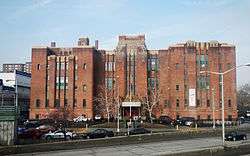 | 2366 Fifth Avenue | 142nd–143rd Streets | Yes | exterior | [40][41] | |
| St. Andrew's Church | 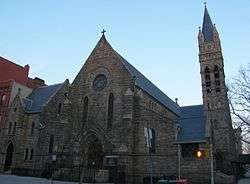 | 2067 Fifth Avenue | 127th Street | Yes | exterior | [40][42] | |
| Harlem Fire Watchtower | 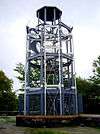 | Marcus Garvey Park | 122nd Street | Yes | exterior | [40][43] | |
| Central Park | .jpg) | N/A | 60th–110th Streets | Yes | Yes | scenic landmark | [40][39][44] |
| Museum of the City of New York | 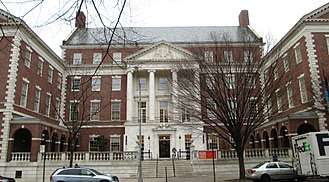 | 1220–1227 Fifth Avenue | 103rd-104th Streets | exterior | [45] | ||
| Willard D. Straight House | 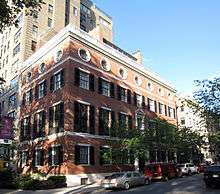 | 1130 Fifth Avenue | 94th Street | exterior | [46] | ||
| Felix M. Warburg House | 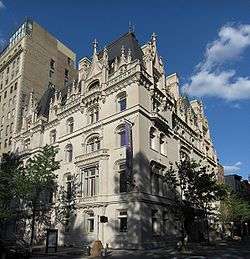 | 1109 Fifth Avenue | 92nd Street | Yes | exterior | [40][47] | |
| Otto H. Kahn House | 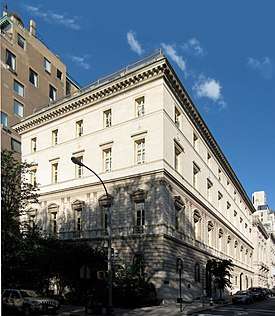 | 1 East 91st Street | 91st Street | exterior | [48] | ||
| Andrew Carnegie Mansion | 2 East 91st Street | 91st Street | Yes | exterior | [40][49] | ||
| Solomon R. Guggenheim Museum | 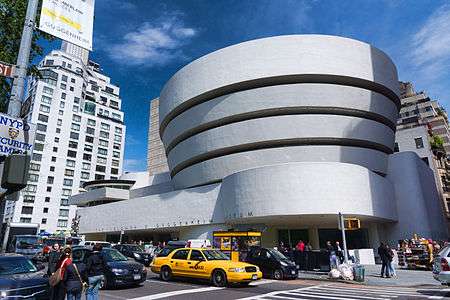 | 1009 Fifth Avenue | 82nd Street | Yes | Yes | exterior and interior | Also designated as WHS[39][40][50][51] |
| Duke Residence | 1009 Fifth Avenue | 82nd Street | Yes | exterior | [40][52] | ||
| Metropolitan Museum of Art | 1000 Fifth Avenue | 80th–84th Streets | Yes | Yes | exterior and interior | [39][40][53] | |
| 998 Fifth Avenue | 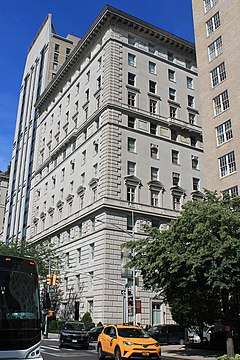 | 998 Fifth Avenue | 81st Street | exterior | [54] | ||
| Payne Whitney House | 972 Fifth Avenue | 78th–79th Streets, midblock | exterior | [55] | |||
| James B. Duke House | 1 East 78th Street | 78th Street | Yes | exterior | [40][56] | ||
| Edward S. Harkness House | 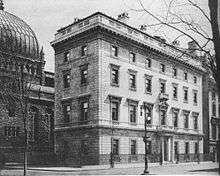 | 1 East 75th Street | 75th Street | exterior | [57] | ||
| Henry Clay Frick House | 1 East 70th Street | 70th Street | Yes | Yes | exterior | [40][39][58] | |
| Robert Livingston Beeckman House | 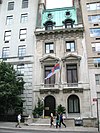 | 854 Fifth Avenue | 66th–67th Streets, midblock | exterior | [59] | ||
| Knickerbocker Club | 2 East 62nd Street | 62nd Street | exterior | [60] | |||
| The Metropolitan Club | 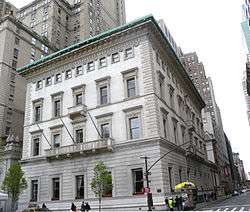 | 2 East 60th Street | 60th Street | exterior | [61] | ||
| Grand Army Plaza | 58th–60th Streets | scenic landmark | [62] | ||||
| The Sherry-Netherland Sidewalk Clock | 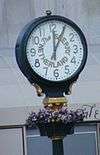 | 783 Fifth Avenue | 59th Street | Yes | [40] | ||
| Plaza Hotel | 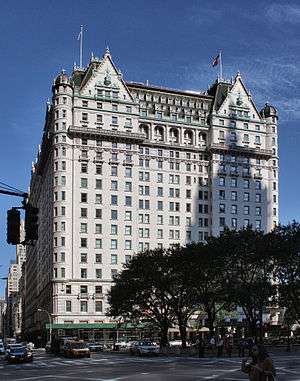 | 768 Fifth Avenue | 58th–59th Streets | Yes | Yes | exterior and interior | [39][40][63] |
| Bergdorf Goodman | .jpg) | 754 Fifth Avenue | 57th–58th Streets | exterior | [64] | ||
| Coty Building | 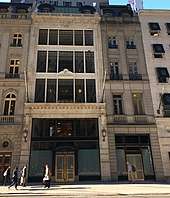 | 714 Fifth Avenue | 55th–56th Streets, midblock | exterior | [65] | ||
| 712 Fifth Avenue | 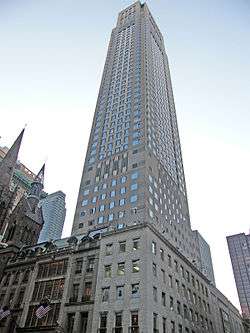 | 712 Fifth Avenue | 55th–56th Streets, midblock | exterior | [66] | ||
| The Peninsula New York | 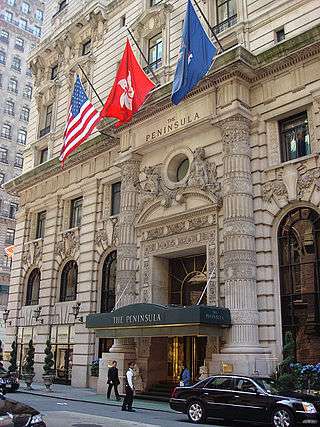 | 696 Fifth Avenue | 55th Street | exterior | [67] | ||
| St. Regis New York | 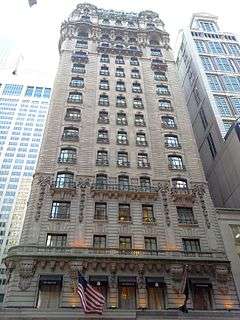 | 693 Fifth Avenue | 55th Street | exterior | [68] | ||
| Aeolian Building (689 Fifth Avenue) | 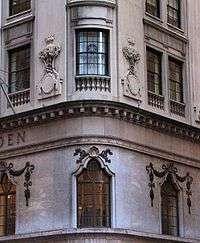 | 689 Fifth Avenue | 54th Street | exterior | [69] | ||
| University Club of New York |  | 1 West 54th Street | 54th Street | exterior | [70] | ||
| Saint Thomas Church | 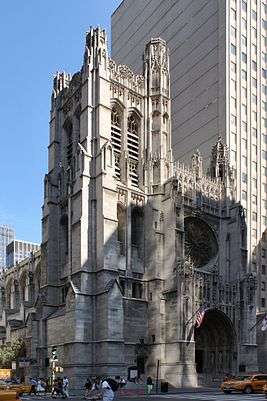 | Corner | 1 West 53rd Street | exterior | [71] | ||
| Morton F. Plant & Edward Holbrook House | 653 Fifth Avenue | 52nd Street | Yes | exterior | [40][72] | ||
| Houses at 647, 651-53 Fifth Avenue and 4 East 52nd Street |  | 647, 651 Fifth Avenue | 52nd Street | Yes | [40] | ||
| Rockefeller Center (including British Empire Building, La Maison Francaise, International Building) | 1–75 Rockefeller Plaza | 49th–51st Streets | Yes | Yes | complex | [39][40][73] | |
| St. Patrick's Cathedral | 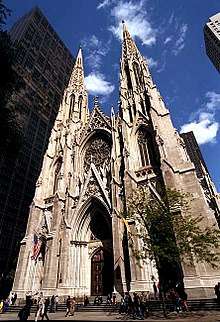 | 460 Madison Avenue | 50th–51st Streets | Yes | Yes | exterior | [39][40][74] |
| Saks Fifth Avenue Building | .jpg) | 611 Fifth Avenue | 49th–50th Streets | exterior | [75] | ||
| Goelet (Swiss Center) Building | .jpg) | 611 Fifth Avenue | 49th–50th Streets | exterior and interior | [76][77] | ||
| Charles Scribner's Sons Building | 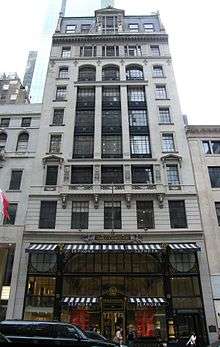 | 597 Fifth Avenue | 48th Street | exterior and interior | [78] | ||
| Fred F. French Building | 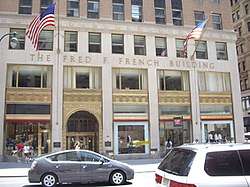 | 551 Fifth Avenue | 45th Street | Yes | exterior and interior | [40][79] | |
| Sidewalk Clock, 522 Fifth Avenue | 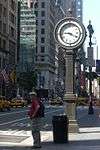 | 522 Fifth Avenue | 44th Street | Yes | object | [40][80] | |
| Manufacturers Trust Company Building | 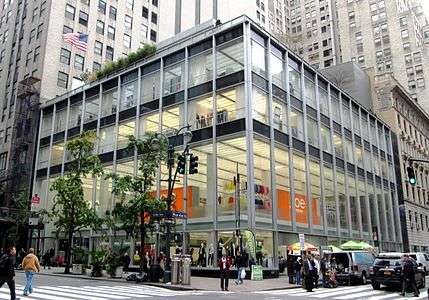 | 510 Fifth Avenue | 43rd Street | exterior and partial interior | [81] | ||
| 500 Fifth Avenue | 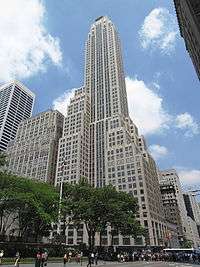 | 500 Fifth Avenue | 42nd Street | exterior | [82] | ||
| New York Public Library Main Branch | 476 Fifth Avenue | 40th–42nd Streets | Yes | Yes | exterior and partial interior | [39][40][83] | |
| Knox Building | 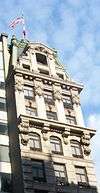 | 452 Fifth Avenue | 40th Street | Yes | exterior | [40][84] | |
| Lord & Taylor Building | 424 Fifth Avenue | 38th Street | exterior | [85] | |||
| Stewart & Company Building | 402 Fifth Avenue | 37th Street | exterior | [86] | |||
| Tiffany and Company Building |  | 401 Fifth Avenue | 37th Street | Yes | exterior | [40][87] | |
| 390 Fifth Avenue | 390 Fifth Avenue | 36th Street | exterior | [88] | |||
| B. Altman and Company Building | 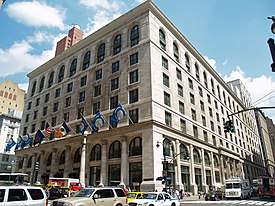 | 355–371 Fifth Avenue | 34th–35th Streets | Yes | [89] | ||
| Empire State Building | .jpg) | 350 Fifth Avenue | 33rd–34th Streets | Yes | Yes | exterior and partial interior | [39][40][90] |
| The Wilbraham | 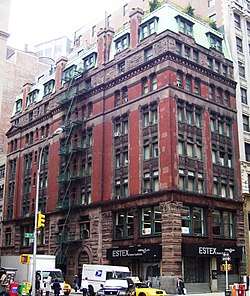 | 284 Fifth Avenue | 30th Street | Yes | exterior | [40][91] | |
| Marble Collegiate Church | 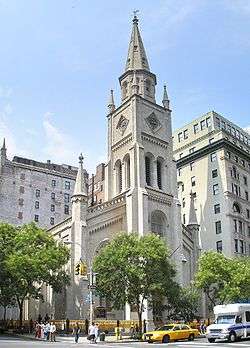 | 272 Fifth Avenue | 29th Street | Yes | exterior | [40][92] | |
| Sidewalk Clock, 200 Fifth Avenue | 200 Fifth Avenue | 24th Street | Yes | object | [40][93] | ||
| Flatiron Building | _en_2010_desde_el_Empire_State_crop_boxin.jpg) | 173–185 Fifth Avenue | 22nd–23rd Streets | Yes | Yes | exterior | [40][39][94] |
| Scribner Building | 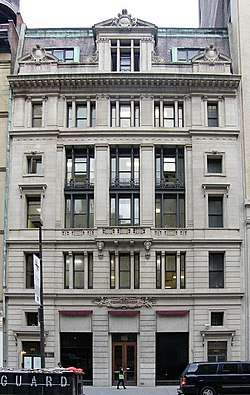 | 153–157 Fifth Avenue | 21st–22nd Streets, midblock | Yes | exterior | [40][95] | |
| Salmagundi Club | 47 Fifth Avenue | 11th–12th Streets, midblock | Yes | exterior | [40][96] |
Historic districts
There are numerous historic districts through which Fifth Avenue passes. Buildings in these districts with individual landmark designations are described in § Individual landmarks. From north to south, the districts are:
- The Carnegie Hill Historic District, a city landmark district, which covers 400 buildings, primarily along Fifth Avenue from 86th to 98th Street, as well as on side streets extending east to Madison, Park, and Lexington Avenues.[97]:3
- The Metropolitan Museum Historic District, a city landmark district, which consists of properties on Fifth Avenue between 79th and 86th Streets, outside the Metropolitan Museum of Art, as well as properties on several side streets.[98]:2
- The Upper East Side Historic District, a city and NRHP district. The city district runs from 59th to 78th Streets along Fifth Avenue, and up to Third Avenue at some points.[99]:3[100]:4
- The Madison Square North Historic District, a city landmark district, which covers 96 buildings from 25th to 29th Streets around Broadway, Fifth Avenue, and side streets.[101]
- The Ladies' Mile Historic District, a city landmark district, which covers 440 buildings from roughly 15th Street to 24th Street and from Park Avenue South to west of Sixth Avenue.[102]
- The Greenwich Village Historic District, a city landmark district, which covers much of Greenwich Village and includes almost all buildings on Fifth Avenue south of 12th Street.[103]
Other
In addition, the cooperative apartment building at 2 Fifth Avenue was named a New York cultural landmark on December 12, 2013 by the Historic Landmark Preservation Center, as the last residence of former New York City Mayor Ed Koch.[104]
Economy
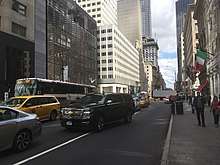
Between 49th Street and 60th Street, Fifth Avenue is lined with prestigious boutiques and flagship stores and is consistently ranked among the most expensive shopping streets in the world.[105]
Many luxury goods, fashion, and sport brand boutiques are located on Fifth Avenue, including Louis Vuitton, Tiffany & Co., Gucci, Prada, Armani, Tommy Hilfiger, Cartier, Omega, Chanel, Harry Winston, Salvatore Ferragamo, Nike, Escada, Rolex, Bvlgari, Emilio Pucci, Ermenegildo Zegna, Abercrombie & Fitch, Hollister Co., De Beers, Emanuel Ungaro, Gap, Versace, Lindt Chocolate Shop, Henri Bendel, NBA Store, Oxxford Clothes, Microsoft Store, Sephora, Tourneau, and Wempe. Luxury department stores include Saks Fifth Avenue and Bergdorf Goodman. Fifth Avenue also is home to New York's fifth most photographed building, the Apple Store.
Many airlines at one time had ticketing offices along Fifth Avenue. In the years leading up to 1992, the number of ticketing offices along Fifth Avenue decreased. Pan American World Airways went out of business, while Air France, Finnair, and KLM moved their ticket offices to other areas in Midtown Manhattan.[106]
Gallery
_pg319_BIRD'S-EYE_VIEW_OF_FIFTH_AVENUE%3B_NORTH_OF_51ST_STREET.jpg) Bird's-eye view looking north from 51st St. c. 1893
Bird's-eye view looking north from 51st St. c. 1893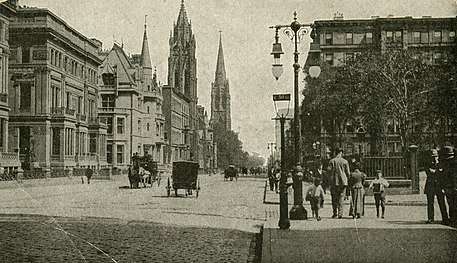 Street view looking north from 51st St. c. 1895
Street view looking north from 51st St. c. 1895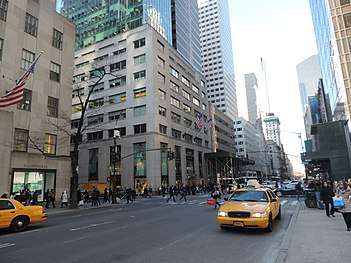 The same shot in March 2015
The same shot in March 2015
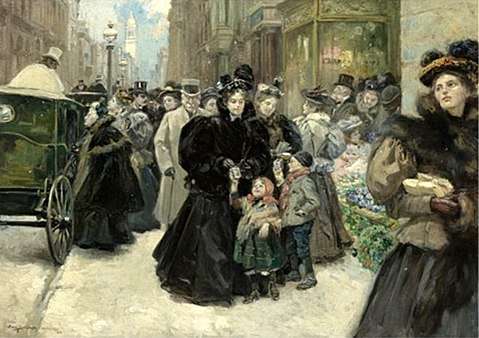 Christmas on Fifth Avenue in 1896
Christmas on Fifth Avenue in 1896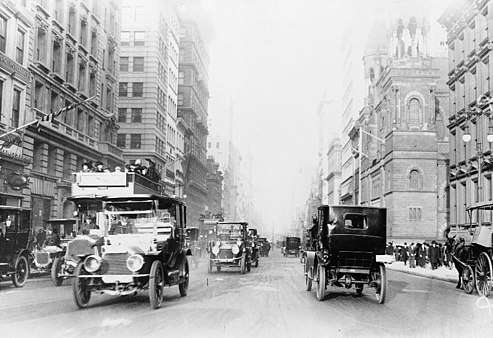 Fifth Avenue, 1918
Fifth Avenue, 1918
- Fifth Avenue begins at the Washington Square Arch in Washington Square Park
- Memorial to New York architect Richard Morris Hunt, Fifth Avenue between 70th and 71st Streets
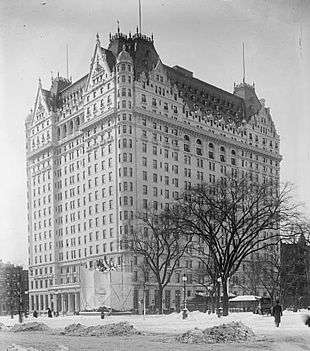 The Plaza Hotel, c.1907
The Plaza Hotel, c.1907
See also
- List of shopping streets and districts by city
- Jerome Avenue, a shopping street and major thoroughfare in the Bronx
- Fifth Avenue Mile, annual road race
References
Notes
- Google (September 12, 2015). "Fifth Avenue (south of 120th Street)" (Map). Google Maps. Google. Retrieved September 12, 2015.
- Google (September 12, 2015). "Fifth Avenue (north of 124th Street)" (Map). Google Maps. Google. Retrieved September 12, 2015.
- "Fifth Avenue The World's Most Expensive Shopping Street (PHOTOS) (Subtext: "For the 9th year in a row, Fifth Avenue between 39th and 60th Streets ranks first among Cushman & Wakefield's Main Streets Across the World Report, according to the New York Post.")". HuffingtonPost.com, Inc. September 21, 2010. Retrieved October 23, 2010.
- Foderaro, Lisa W. "Survey Reaffirms 5th Ave. at Top of the Retail Rent Heap", The New York Times, April 29, 1997. Retrieved February 5, 2008.
- Wist, Ronda (1992). On Fifth Avenue : then and now. New York: Carol Pub. Group. ISBN 978-1-55972-155-4. OCLC 26852090.
- "Mr. Edward Harriman..." (PDF). The Real Estate Record: Real estate record and builders' guide. 79 (2038): 296. April 6, 1907 – via columbia.edu.
- "- Manhattan NYC New York Penthouses for Sale and Rent. Manhattan Penthouse Apartments". www.nycpenthouses.com.
- Great Places in America. Planning.org (February 24, 2011). Retrieved July 19, 2013.
- Kilgannon, Corey. "The Empty Storefronts of New York: A Panoramic View". Retrieved October 17, 2018.
- Kihbaconss, Peter. "5th and Madison Avenues Become One-Way Friday; Change to Come 7 Weeks Ahead of Schedule to Ease Strike Traffic 5th and Madison to Be Made One-Way Friday", The New York Times, January 12, 1966. Retrieved December 6, 2007. "The long-argued conversion of Fifth and Madison Avenues to one-way streets will start at 6 am. Friday seven weeks ahead of schedule to ease congestion caused by the transit strike."
- "Giannina Braschi". National Book Festival. Library of Congress. 2012.
’Braschi, one of the most revolutionary voices in Latin America today’ is the author of Empire of Dreams.
- Marting, Diane (2010), New/Nueva York in Giannina Braschi's 'Poetic Egg': Fragile Identity, Postmodernism, and Globalization, Indiana: The Global South, pp. 167–182.
- New York City Cycling Map Archived February 19, 2016, at the Wayback Machine, New York City Department of City Planning. Retrieved April 27, 2009.
- Dunham, Mary Frances. "Bicycle Blueprint – Fifth, Park and Madison" Archived March 4, 2016, at the Wayback Machine, Transportation Alternatives. Retrieved April 27, 2009.
- Yee, Marilynn K. "Ban on Bikes Could Bring More Mopeds", The New York Times, Tuesday, August 25, 1987. Retrieved April 27, 2009.
- Higgins Jr., Chester. "Bike Messengers: Life in Tight Lane", The New York Times, Friday, September 4, 1987. Retrieved April 27, 2009.
- Neuman, William "Step to the Rear of the Bus, Please, or Take a Seat Upstairs", The New York Times, Tuesday, May 23, 2008.
- "Manhattan Bus Map" (PDF). Metropolitan Transportation Authority. December 2017. Retrieved April 24, 2018.
- See:
- "Brooklyn Bus Map" (PDF). Metropolitan Transportation Authority. November 2017. Retrieved April 24, 2018.
- "Bronx Bus Service" (PDF). Metropolitan Transportation Authority. September 2017. Retrieved April 24, 2018.
- "Staten Island Bus Map" (PDF). Metropolitan Transportation Authority. August 2018. Retrieved August 18, 2018.
- The smallest apartment was a half-floor, of 12 rooms; 907 Fifth Avenue.
- J. E. R. Carpenter, The Architect Who Shaped Upper Fifth Avenue, New York Times, August 26, 2007, Christopher Gray,
- Entrepreneur Magazine: "Built for Business: Midtown Manhattan in the 1920s". Retrieved November 11, 2014
- Ng, Diana. "Museum Mile" in Jackson, Kenneth T., ed. (2010). The Encyclopedia of New York City (2nd ed.). New Haven: Yale University Press. ISBN 978-0-300-11465-2., p.867
- Street signs saying "Museum Mile" actually extend to 80th Street. "Street View: 80th Street and Fifth Avenue, New York" Google Maps
- Kusisto, Laura (October 21, 2011). "Reaching High on Upper 5th Avenue". The Wall Street Journal. Archived from the original on October 23, 2011. Retrieved February 22, 2013.
- "Museums on the Mile". Archived from the original on January 1, 2012. Retrieved June 24, 2011.
- Sewell Chan (February 9, 2007). "Museum for African Art Finds its Place". The New York Times. Retrieved July 15, 2008.
- "New Drive Promoting 5th Ave.'s 'Museum Mile'". The New York Times. June 27, 1979. Retrieved July 15, 2008.
- "Museum Mile Festival held in New York" UPI NewsTrack (June 8, 2004.)
- New drive promoting Fifth Avenue's 'Museum Mile', The New York Times, June 27, 1979.
- Fass, Allison and Murray, Liz (2000) "Talking to the Streets for Art" The New York Times June 11, 2000, p.17, col. 2.
- Catton, Pia (June 14, 2011). "Another Delay for Museum of African Art". The Wall Street Journal. Retrieved June 24, 2011.
- "The Frick Collection and Frick Art Reference Library Building". National Historic Landmark summary listing. National Park Service. Archived from the original on July 29, 2013. Retrieved November 8, 2013.
- "Landmark Types and Criteria - LPC". Welcome to NYC.gov. Retrieved December 22, 2019.
- "How to List a Property". National Register of Historic Places (U.S. National Park Service). November 26, 2019. Retrieved December 22, 2019.
- "Eligibility". National Historic Landmarks (U.S. National Park Service). August 29, 2018. Retrieved December 22, 2019.
- UNESCO World Heritage Centre (October 11, 2017). "The Criteria for Selection". UNESCO World Heritage Centre. Retrieved December 22, 2019.
- "Discover New York City Landmarks". New York City Landmarks Preservation Commission. Retrieved December 21, 2019 – via ArcGIS.
- "National Historic Landmarks Program" (PDF). Archived from the original (PDF) on January 24, 2011. Retrieved February 19, 2011.
- "National Register Information System". National Register of Historic Places. National Park Service. November 2, 2013.
- "369th Regiment Armory" (PDF). New York City Landmarks Preservation Commission. May 14, 1985. Retrieved December 9, 2019.
- "Saint Andrew's Church" (PDF). New York City Landmarks Preservation Commission. April 12, 1967. Retrieved December 9, 2019.
- "Watch Tower" (PDF). New York City Landmarks Preservation Commission. July 12, 1967. Retrieved December 6, 2019.
- "Central Park" (PDF). New York City Landmarks Preservation Commission. April 16, 1974. Retrieved December 9, 2019.
- "Willard and Dorothy Whitney Straight House" (PDF). New York City Landmarks Preservation Commission. May 15, 1968. Retrieved December 6, 2019.
- "Willard and Dorothy Whitney Straight House" (PDF). New York City Landmarks Preservation Commission. May 15, 1968. Retrieved December 6, 2019.
- "Felix M. Warburg House" (PDF). New York City Landmarks Preservation Commission. November 24, 1981. Retrieved December 6, 2019.
- "Otto and Addie Kahn House" (PDF). New York City Landmarks Preservation Commission. February 19, 1974. Retrieved December 6, 2019.
- "Andrew and Louise Carnegie House" (PDF). New York City Landmarks Preservation Commission. February 19, 1974. Retrieved December 6, 2019.
- "The Solomon R. Guggenheim Museum" (PDF). New York City Landmarks Preservation Commission. August 14, 1990. Retrieved June 18, 2019.
- "The Solomon R. Guggenheim Museum: Interior" (PDF). New York City Landmarks Preservation Commission. August 14, 1990. Retrieved June 18, 2019.
- "The 20th-Century Architecture of Frank Lloyd Wright". UNESCO World Heritage Centre. Retrieved July 7, 2019.
- "1009 Fifth Avenue House" (PDF). New York City Landmarks Preservation Commission. February 19, 1974. Retrieved December 6, 2019.
- "Metropolitan Museum of Art" (PDF). New York City Landmarks Preservation Commission. June 9, 1967. Retrieved July 28, 2019.
- "Metropolitan Museum of Art" (PDF). New York City Landmarks Preservation Commission. November 19, 1977. Retrieved July 28, 2019.
- "998 Fifth Avenue Apartment House" (PDF). New York City Landmarks Preservation Commission. February 19, 1974. Retrieved December 6, 2019.
- "Payne and Helen Hay Whitney House" (PDF). New York City Landmarks Preservation Commission. September 15, 1970. Retrieved December 6, 2019.
- "James B. and Nanaline Duke House" (PDF). New York City Landmarks Preservation Commission. September 15, 1970. Retrieved December 6, 2019.
- "Edward S. and Mary Stillman Harkness House" (PDF). New York City Landmarks Preservation Commission. January 25, 1975. Retrieved December 6, 2019.
- "Henry Clay and Adelaide Childs Frick House" (PDF). New York City Landmarks Preservation Commission. March 20, 1973. Retrieved December 6, 2019.
- "R. Livingston and Eleanor T. Beeckman House" (PDF). New York City Landmarks Preservation Commission. January 14, 1969. Retrieved December 6, 2019.
- "Knickerbocker Club Building" (PDF). New York City Landmarks Preservation Commission. September 11, 1979. Retrieved December 6, 2019.
- "Metropolitan Club Building" (PDF). New York City Landmarks Preservation Commission. September 11, 1979. Retrieved December 6, 2019.
- "Central Park" (PDF). New York City Landmarks Preservation Commission. April 16, 1974. Retrieved December 9, 2019.
- "Plaza Hotel" (PDF). New York City Landmarks Preservation Commission. December 9, 1969. Retrieved December 6, 2019.
- "Plaza Hotel Interiors" (PDF). New York City Landmarks Preservation Commission. July 12, 2005. Retrieved December 6, 2019.
- "Bergdorf Goodman" (PDF). New York City Landmarks Preservation Commission. December 13, 2016. Retrieved December 6, 2019.
- "Coty Building" (PDF). New York City Landmarks Preservation Commission. January 29, 1985. Retrieved December 6, 2019.
- "712 Fifth Avenue Building" (PDF). New York City Landmarks Preservation Commission. January 29, 1985. Retrieved December 6, 2019.
- "Gotham Hotel" (PDF). New York City Landmarks Preservation Commission. June 6, 1989. Retrieved December 6, 2019.
- "St. Regis Hotel" (PDF). New York City Landmarks Preservation Commission. November 1, 1988. Retrieved December 6, 2019.
- "Aeolian Building" (PDF). New York City Landmarks Preservation Commission. December 10, 2002. Retrieved December 6, 2019.
- "University Club" (PDF). New York City Landmarks Preservation Commission. January 11, 1967. Retrieved December 6, 2019.
- "Saint Thomas Church and Parish House" (PDF). New York City Landmarks Preservation Commission. October 19, 1966. Retrieved December 6, 2019.
- "Morton and Nellie Plant House and Edward and Frances Holbrook House" (PDF). New York City Landmarks Preservation Commission. July 14, 1970. Retrieved December 6, 2019.
- "Rockefeller Center" (PDF). New York City Landmarks Preservation Commission. April 23, 1985. Retrieved December 6, 2019.
- "Saint Patrick's Cathedral Complex" (PDF). New York City Landmarks Preservation Commission. October 19, 1966. Retrieved December 6, 2019.
- "Saks Fifth Avenue" (PDF). New York City Landmarks Preservation Commission. December 20, 1984. Retrieved December 6, 2019.
- "Goelet Building" (PDF). New York City Landmarks Preservation Commission. January 14, 1992. Retrieved December 6, 2019.
- "Goelet Building (Interior)" (PDF). New York City Landmarks Preservation Commission. January 14, 1992. Retrieved December 6, 2019.
- "Charles Scribner's Sons Building" (PDF). New York City Landmarks Preservation Commission. March 23, 1982. Retrieved December 6, 2019.
- "Charles Scribner's Sons Building [Interior]" (PDF). New York City Landmarks Preservation Commission. July 11, 1989. Retrieved December 6, 2019.
- "Fred F. French Building" (PDF). New York City Landmarks Preservation Commission. March 18, 1986. Retrieved December 6, 2019.
- "Fred F. French Building [Interior]" (PDF). New York City Landmarks Preservation Commission. March 18, 1986. Retrieved December 6, 2019.
- "Sidewalk Clock, 522 Fifth Avenue" (PDF). New York City Landmarks Preservation Commission. August 25, 1981. Retrieved December 6, 2019.
- "Manufacturers Trust Company Building" (PDF). New York City Landmarks Preservation Commission. October 21, 1997. Retrieved December 6, 2019.
- "Manufacturers Trust Company Building, First and Second Floor Interiors" (PDF). New York City Landmarks Preservation Commission. February 15, 2011. Retrieved December 6, 2019.
- "500 Fifth Avenue Building" (PDF). New York City Landmarks Preservation Commission. December 14, 2010. Retrieved December 6, 2019.
- "New York Public Library" (PDF). New York City Landmarks Preservation Commission. January 11, 1967. Retrieved December 6, 2019.
- "New York Public Library: Main Lobby, the North and South Staircases from the First Floor to the Third Floor, and the Central Hall on the Third Floor" (PDF). New York City Landmarks Preservation Commission. November 12, 1974. Retrieved December 6, 2019.
- Postal, Matthew A. (August 8, 2017). "New York Public Library (Stephen A. Schwarzman Building) Interiors, Main Reading Room and Catalog Room" (PDF). New York City Landmarks Preservation Commission. Retrieved December 6, 2019.
- "Knox Building" (PDF). New York City Landmarks Preservation Commission. September 23, 1980. Retrieved December 6, 2019.
- "Lord & Taylor Building" (PDF). New York City Landmarks Preservation Commission. October 30, 2007. Retrieved December 6, 2019.
- "Stewart & Company Building" (PDF). New York City Landmarks Preservation Commission. April 18, 2006. Retrieved December 6, 2019.
- "Tiffany & Company Building" (PDF). New York City Landmarks Preservation Commission. February 16, 1988. Retrieved December 6, 2019.
- "Gorham Building" (PDF). New York City Landmarks Preservation Commission. December 15, 1998. Retrieved December 6, 2019.
- "B. Altman and Company Department Store" (PDF). New York City Landmarks Preservation Commission. March 12, 1985. Retrieved December 6, 2019.
- "Empire State Building" (PDF). New York City Landmarks Preservation Commission. May 19, 1981. Retrieved December 6, 2019.
- "Empire State Building [Interior]" (PDF). New York City Landmarks Preservation Commission. May 19, 1981. Retrieved December 6, 2019.
- "The Wilbraham" (PDF). New York City Landmarks Preservation Commission. June 8, 2004. Retrieved December 6, 2019.
- "Marble Collegiate Church" (PDF). New York City Landmarks Preservation Commission. January 11, 1967. Retrieved December 6, 2019.
- "Sidewalk Clock, 200 Fifth Avenue" (PDF). New York City Landmarks Preservation Commission. August 25, 1981. Retrieved December 6, 2019.
- "Flatiron Building" (PDF). New York City Landmarks Preservation Commission. September 29, 1966. Retrieved December 6, 2019.
- "Scribner Building" (PDF). New York City Landmarks Preservation Commission. September 14, 1976. Retrieved December 6, 2019.
- "Irad Hawley House" (PDF). New York City Landmarks Preservation Commission. September 9, 1969. Retrieved December 6, 2019.
- "Expanded Carnegie Hill Historic District" (PDF). New York City Landmarks Preservation Commission. December 21, 1993. Retrieved December 6, 2019.
- "Metropolitan Museum Historic District" (PDF). New York City Landmarks Preservation Commission. September 20, 1977. Retrieved December 6, 2019.
- "Upper East Side Historic District" (PDF). New York City Landmarks Preservation Commission. May 19, 1981. Retrieved December 6, 2019.
- "Upper East Side Historic District Extension" (PDF). New York City Landmarks Preservation Commission. March 23, 2010. Retrieved December 6, 2019.
- "Madison Square North Historic District" (PDF). New York City Landmarks Preservation Commission. June 26, 2001. Retrieved December 6, 2019.
- "Ladies' Mile Historic District" (PDF). New York City Landmarks Preservation Commission. May 2, 1989. Retrieved December 6, 2019.
- "Greenwich Village Historic District" (PDF). New York City Landmarks Preservation Commission. April 29, 1969. Retrieved December 6, 2019.
- Roberts, Sam (December 12, 2013). "Koch's Last Residence Is Named a Cultural Landmark". The New York Times. Retrieved May 14, 2015.
- "Fifth Avenue The World's Most Expensive Shopping Street (PHOTOS) (Subtext: "For the 9th year in a row, Fifth Avenue between 49th and 60th Streets ranks first among Cushman & Wakefield's Main Streets Across the World Report, according to the New York Post.")". HuffingtonPost.com, Inc. September 21, 2010. Retrieved October 23, 2010.
- "POSTINGS: Air France Takes Flight; Au Revoir, Fifth Avenue." The New York Times. May 24, 1992. Page 101, New York Edition. Retrieved February 13, 2010.
Further reading
- Gaines, Steven (2005). The Sky's the Limit: Passion and Property in Manhattan. New York: Little, Brown. ISBN 0-316-60851-3.
- "Museum Mile". NY.com. Retrieved February 22, 2013.
- Daly, Sean (April 13, 2003). "Museum Mile High". The Washington Post. Retrieved July 15, 2008. (Note: Erroneously states the northern boundary of Museum Mile is East 104th Street.)
External links
| Wikimedia Commons has media related to 5th Avenue (Manhattan). |
- Fifth Avenue Photos
- Fifth Avenue Directory and Images
- Greek Independence Day Parade, Fifth Avenue
- New York Songlines: Fifth Avenue
- APA Great Places in America
- National Historic Landmarks in New York State
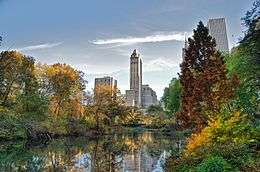

.jpg)